Low VOC Paint Market Size
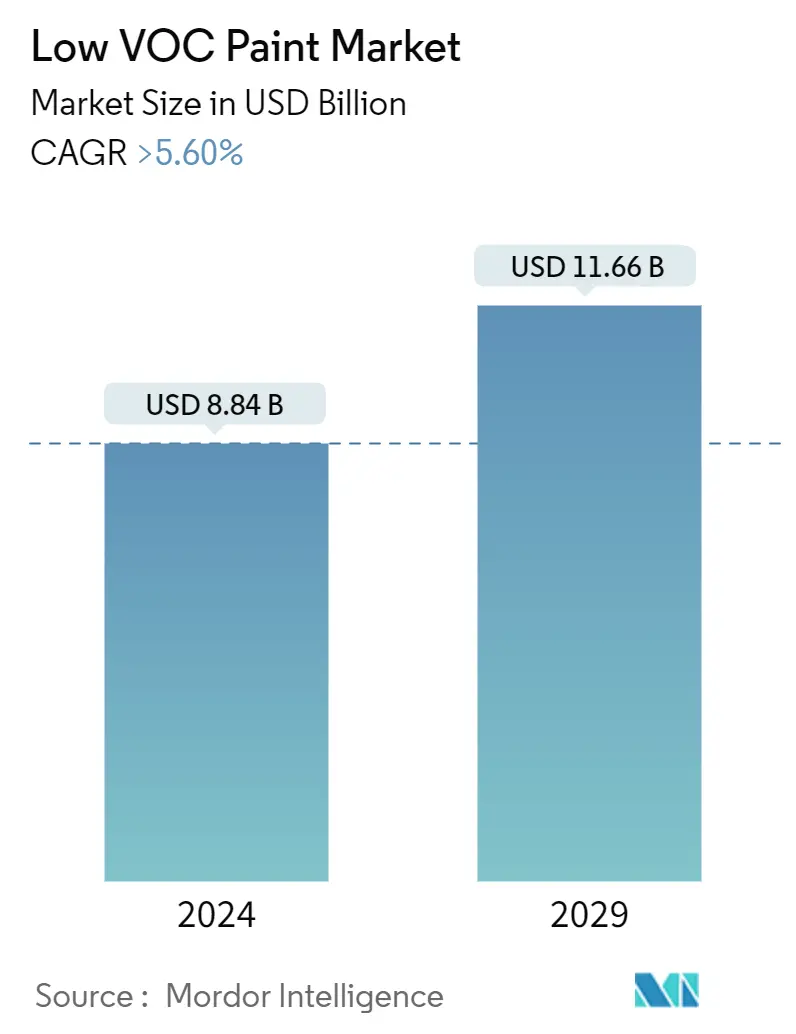
| Study Period | 2019 - 2029 |
| Market Size (2024) | USD 8.84 Billion |
| Market Size (2029) | USD 11.66 Billion |
| CAGR (2024 - 2029) | 5.60 % |
| Fastest Growing Market | Asia Pacific |
| Largest Market | Asia Pacific |
Major Players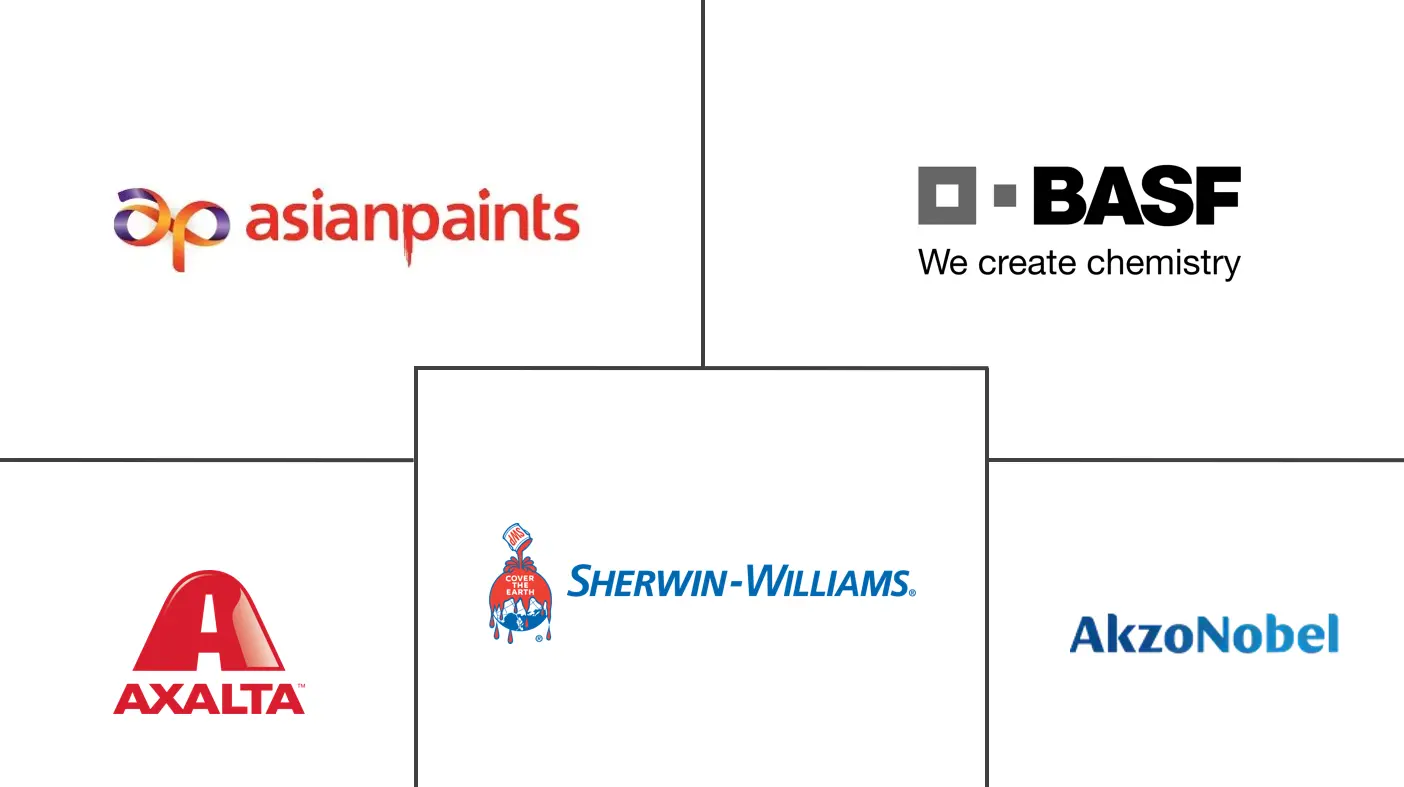
*Disclaimer: Major Players sorted in no particular order |
Low VOC Paint Market Analysis
The Low VOC Paint Market size is estimated at USD 8.84 billion in 2024, and is expected to reach USD 11.66 billion by 2029, growing at a CAGR of greater than 5.60% during the forecast period (2024-2029).
- The COVID-19 pandemic impacted the low VOC paint market in 2020 and 2021, driven by reduced economic and commercial activities coupled with declines in construction and industrial output. But the market recovered in recent years and is anticipated to grow over the period.
- The increasing awareness about the harmful effects of conventional paints, which is contrary to low VOC paints as they are eco-friendly and safe to use, is expected to drive the market's growth during the forecast period.
- On the other hand, the high cost of low VOC paint compared to conventional paint is expected to hinder the market's growth.
- The increasing construction of green buildings, shift toward eco-friendly chemicals, and recycling of low VOC paint will likely provide opportunities for the market studied during the forecast period.
- Asia-Pacific dominated the global market due to the high consumption of low-VOC paints from the architectural industry.
Low VOC Paint Market Trends
Architectural and Decorative Segment to Dominate the Market
- Decorative paints help protect the surface from the impact of weather, make the surface waterproof, protect the surface from termite attacks, and increase surface durability, providing an aesthetic appeal to the building.
- In addition, they offer protection from corrosion, bacteria, UV radiation, fungus, water seepage, and algae and enhance the structure's life.
- The demand for Low VOC paints is dominated by the architectural and decorative industry, driven by the growing residential and commercial construction activities worldwide.
- China's growth is fueled mainly by rapid residential and commercial building expansion. The country's construction output peaked in 2022 at about USD 4.64 trillion (31.2 trillion yuan). As a result, these factors tend to increase the market demand during the forecast period.
- According to the US Census Bureau, the value of completed commercial construction has rebounded to pre-recession levels, reaching USD 115 billion in 2022. The most popular types of commercial development started in the United States were warehouses and private offices. Additionally, during the first eight months of 2023, construction spending amounted to USD 1,284.7 billion, which increased by 4.2% to USD 1,233.4 billion for the same period in 2022.
- Furthermore, according to Eurostat, the European construction sector grew by 2.5% in 2022 due to new investments from the EU Recovery Fund. The major construction projects in 2022 accounted for non-residential construction (offices, hospitals, hotels, schools, and industrial buildings), accounting for 31.3% of total activity.
- Such construction activities are expected to increase the demand During the forecast period such as low-VOC paints.
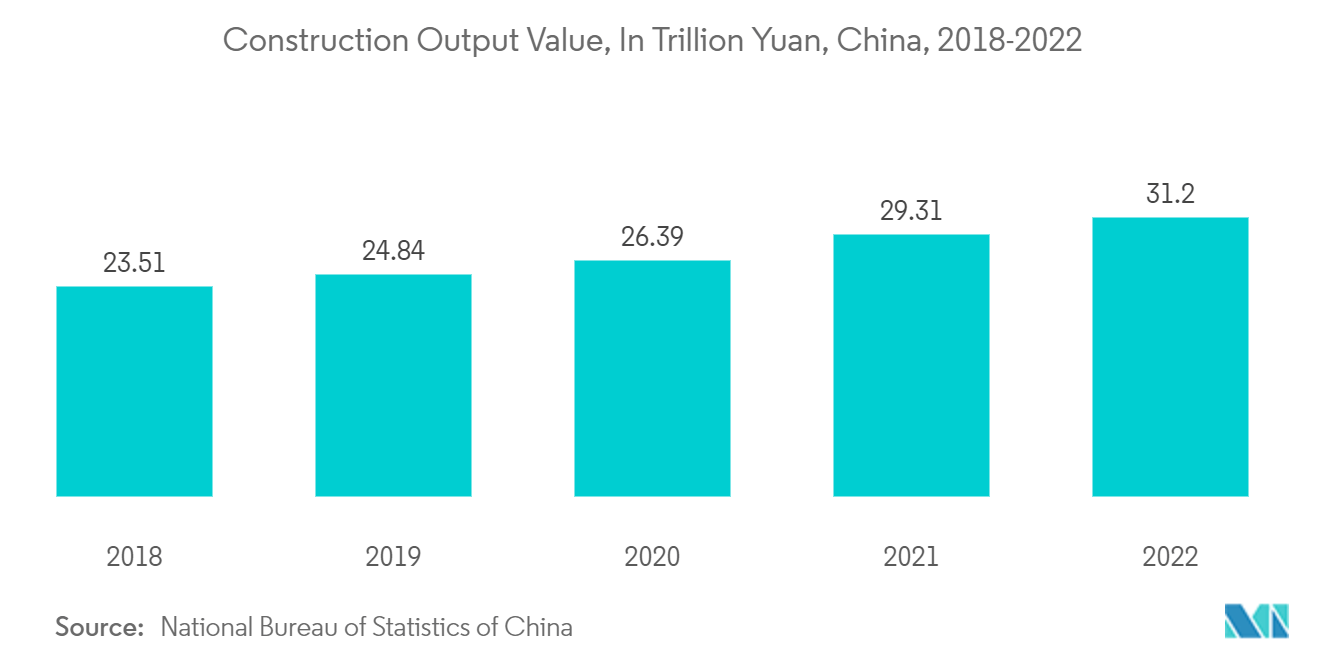
Asia-Pacific Region to Dominate the Market
- Asia-Pacific region dominated the global market share. With growing investment in residential and commercial construction in countries such as India, China, the Philippines, Vietnam, and Indonesia, the market for low-VOC paints is expected to increase in the coming years.
- Low-VOC paints are widely used in the construction industry as it is eco-friendly compared to regular paints. Low VOC paints are used for various applications, including painting interior and exterior walls, ceilings, trim, concrete floors, metal surfaces, furniture, and cabinets.
- The construction industry is expected to record an average annual growth rate of 4.3% between 2024 and 2027, supported by investment in infrastructure as part of the 14th Five-Year Plan (FYP 2021-2025). Additionally, growth in the industry will also be aided by CNY 6.8 trillion (USD 1.1 trillion) of government funds for infrastructure construction projects by 2030. In 2022, the National Development and Reform Commission (NDRC) approved 109 fixed asset investment projects worth CNY 1.5 trillion (USD 222.3 billion).
- According to the Government of China, in January 2023, announced the new credit policy aims to drive urban housing sales in the country. To drive housing sales in China, many local authorities announced voucher schemes. Earlier in 2022, the government also announced a pledge of USD 29 billion in special loans, thereby allowing construction firms to finish stalled projects.
- Furthermore, the Indian government is likely to invest around USD 1.3 trillion in housing over the next seven years. It is expected to see the construction of 60 million new homes. Such projects are driving the low VOC paints market in the construction industry.
- Moreover, the Indonesian government has started a program to build about one million housing units across Indonesia, for which the government has allocated about USD 1 billion in the budget. Thus boosting the market growth significantly.
- Low VOC paints contain significantly less VOCs than traditional paints, making them a more environmentally friendly and healthier option. In the automotive industry, low VOC paints are used for painting exteriors and interior surfaces of the vehicle, automotive tire parts and refinishing damaged vehicles.
- According to the China Association of Automobile Manufacturers (CAAM), China has the most significant automotive production base in the world, with a total vehicle production of around 27.02 million units in 2022, registering an increase of 3.4 % compared to 26.12 million units produced last year. Thus providing a massive market for low-VOC paint in the automotive sector.
- Thus, the factors above are expected to drive the demand for low-VOC paints in the region during the forecast period.
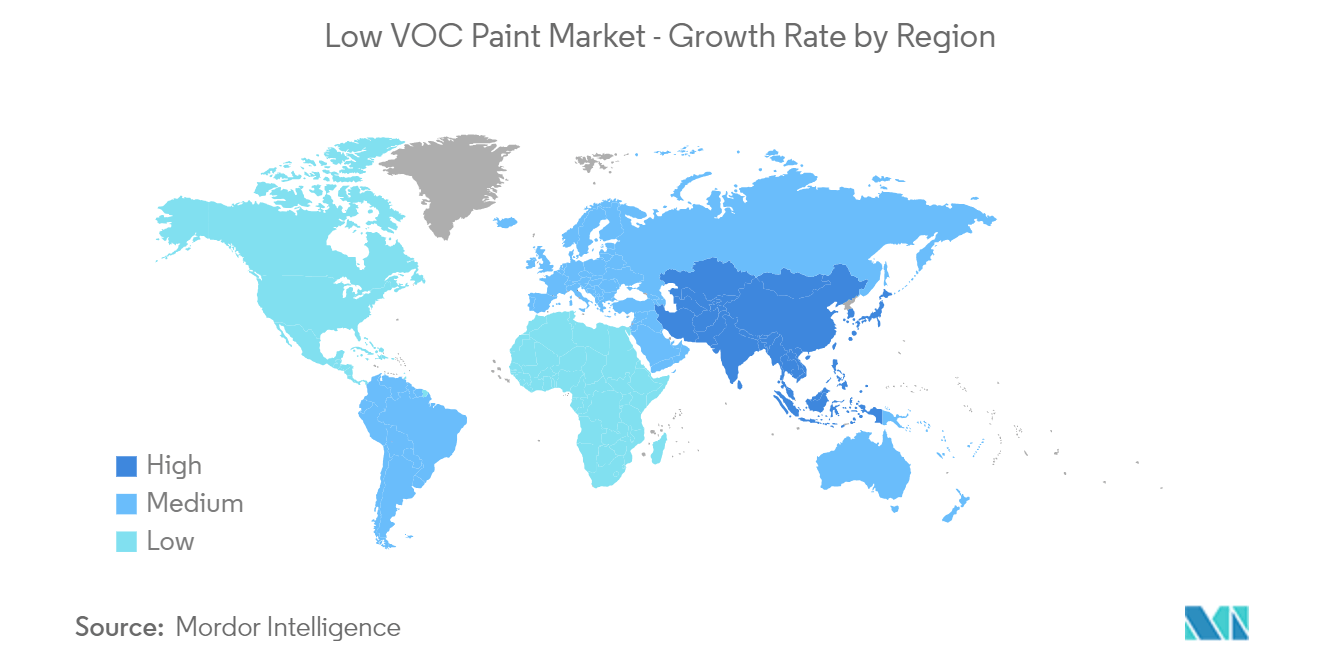
Low VOC Paint Industry Overview
The low VOC paint market is partially fragmented in nature. The major players (not in any particular order) include Akzo Nobel N.V., Asian Paints, BASF SE, Axalta Coating Systems, LLC, and The Sherwin-Williams Company, among others.
Low VOC Paint Market Leaders
-
BASF SE
-
The Sherwin-Williams Company
-
Akzo Nobel N.V.
-
Axalta Coating Systems, LLC
-
Asian Paints
*Disclaimer: Major Players sorted in no particular order
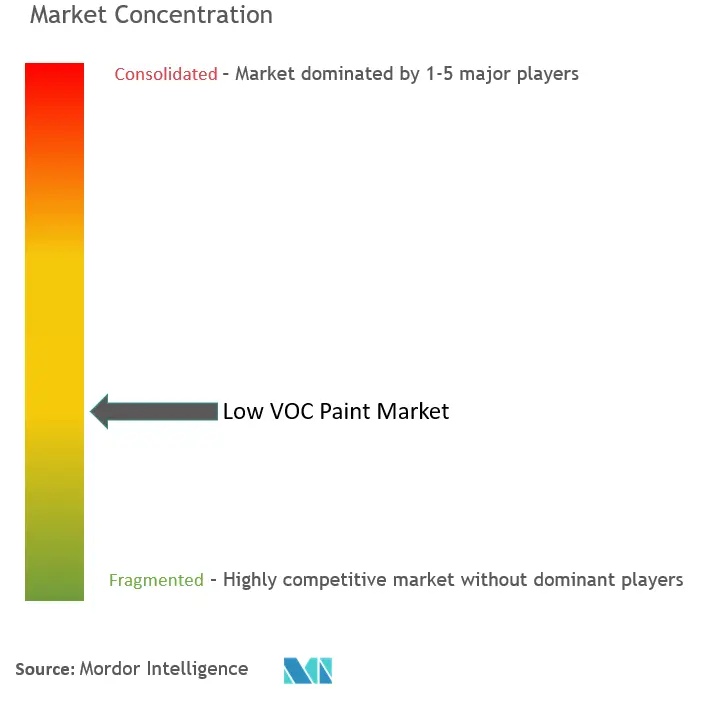
Low VOC Paint Market News
July 2023: Crown Trade aims to strengthen its commitment to creating a more sustainable built environment with the launch of an innovative new air purifying paint that’s ultra-low in volatile organic compounds (VOCs). The product contains advanced air purifying technology that removes up to 45% of formaldehyde from the air, helping to improve indoor air quality from the very first coat.
August 2022: Arkema, a global leader in specialty materials for paints and coatings, launched SYNAQUA 9511, a new performance waterborne binder for use in formulating industrial paints with low VOC levels (150 g/l).
Low VOC PaintMarket Report - Table of Contents
1. INTRODUCTION
- 1.1 Study Deliverables
- 1.2 Study Assumptions
- 1.3 Scope of the Study
2. RESEARCH METHODOLOGY
3. EXECUTIVE SUMMARY
4. MARKET DYNAMICS
-
4.1 Drivers
- 4.1.1 Increasing Awareness about Harmful Effects of Conventional Paint
- 4.1.2 increasing Demand in Architectural and Decorative Industry
- 4.1.3 Other Drivers
-
4.2 Restraints
- 4.2.1 High Cost in Comparison to Conventional Paint
- 4.2.2 Other Restraints
- 4.3 Industry Value Chain Analysis
-
4.4 Porter's Five Forces Analysis
- 4.4.1 Bargaining Power of Suppliers
- 4.4.2 Bargaining Power of Buyers
- 4.4.3 Threat of New Entrants
- 4.4.4 Threat of Substitute Products and Services
- 4.4.5 Degree of Competition
5. MARKET SEGMENTATION (Market Size in Value)
-
5.1 Type
- 5.1.1 Low-VOC
- 5.1.2 No or Zero VOC
- 5.1.3 Natural
-
5.2 Formulation Type
- 5.2.1 Water-borne
- 5.2.2 Solvent-borne
- 5.2.3 Powder
-
5.3 Application
- 5.3.1 Architecture and Decorative
- 5.3.2 General Industrial
- 5.3.3 Automotive OEM
- 5.3.4 Automotive Refinish
- 5.3.5 Marine
- 5.3.6 Consumer Durables
- 5.3.7 Other Applications (Pharmaceuticals, Electronics, etc.)
-
5.4 Geography
- 5.4.1 Asia-Pacific
- 5.4.1.1 China
- 5.4.1.2 India
- 5.4.1.3 Japan
- 5.4.1.4 South Korea
- 5.4.1.5 Rest of Asia-Pacific
- 5.4.2 North America
- 5.4.2.1 United States
- 5.4.2.2 Canada
- 5.4.2.3 Mexico
- 5.4.3 Europe
- 5.4.3.1 Germany
- 5.4.3.2 United Kingdom
- 5.4.3.3 France
- 5.4.3.4 Italy
- 5.4.3.5 Rest of Europe
- 5.4.4 South America
- 5.4.4.1 Brazil
- 5.4.4.2 Argentina
- 5.4.4.3 Rest of South America
- 5.4.5 Middle-East and Africa
- 5.4.5.1 Saudi Arabia
- 5.4.5.2 South Africa
- 5.4.5.3 Rest of Middle-East and Africa
6. COMPETITIVE LANDSCAPE
- 6.1 Mergers and Acquisitions, Joint Ventures, Collaborations, and Agreements
- 6.2 Market Share(%)**/Ranking Analysis
- 6.3 Strategies Adopted by Leading Players
-
6.4 Company Profiles
- 6.4.1 Akzo Nobel N.V.
- 6.4.2 American Formulating & Manufacturing
- 6.4.3 Arkema
- 6.4.4 Asian Paints
- 6.4.5 AURO
- 6.4.6 Axalta Coating Systems, LLC
- 6.4.7 BASF SE
- 6.4.8 Benjamin Moore & Co.
- 6.4.9 Berger Paints India Limited
- 6.4.10 BioShield Paint Company
- 6.4.11 Cloverdale Paint Inc.
- 6.4.12 Crown Trade
- 6.4.13 Fine Paints of Europe
- 6.4.14 Jotun
- 6.4.15 Kalekim
- 6.4.16 Kansai Paint Co.,Ltd.
- 6.4.17 Nippon Paint Holdings Co., Ltd.
- 6.4.18 PPG Industries, Inc.
- 6.4.19 The Sherwin-Williams Company
- *List Not Exhaustive
7. MARKET OPPORTUNITIES AND FUTURE TRENDS
- 7.1 Increasing Construction of Green Buildings
- 7.2 Shift toward Eco-friendly Chemicals
Low VOC Paint Industry Segmentation
Low VOC Paints contain fewer Volatile Organic Compounds (VOC) or solvents than conventional coatings. As VOCs evaporate and release hazardous chemicals into the air, adopting low-VOC products is preferable for improving air quality and helping to increase environmental sustainability.
The low VOC paint market is segmented by type, formulation type, application, and geography. By type, the market is segmented into low VOC, no or zero VOC, and natural. By formulation type, the market is segmented into water-borne, solvent-borne, and powder. By application, the market is segmented into architecture and decorative, general industrial, automotive OEM, automotive refinish, marine, consumer durables, and other applications (pharmaceuticals, electronics, etc.). The report also covers the market size and forecasts for the low VOC paint market for 15 countries across major regions.
For each segment, the market sizing and forecasts have been done based on value (USD).
| Type | Low-VOC | |
| No or Zero VOC | ||
| Natural | ||
| Formulation Type | Water-borne | |
| Solvent-borne | ||
| Powder | ||
| Application | Architecture and Decorative | |
| General Industrial | ||
| Automotive OEM | ||
| Automotive Refinish | ||
| Marine | ||
| Consumer Durables | ||
| Other Applications (Pharmaceuticals, Electronics, etc.) | ||
| Geography | Asia-Pacific | China |
| India | ||
| Japan | ||
| South Korea | ||
| Rest of Asia-Pacific | ||
| Geography | North America | United States |
| Canada | ||
| Mexico | ||
| Geography | Europe | Germany |
| United Kingdom | ||
| France | ||
| Italy | ||
| Rest of Europe | ||
| Geography | South America | Brazil |
| Argentina | ||
| Rest of South America | ||
| Geography | Middle-East and Africa | Saudi Arabia |
| South Africa | ||
| Rest of Middle-East and Africa |
Low VOC PaintMarket Research FAQs
How big is the Low VOC Paint Market?
The Low VOC Paint Market size is expected to reach USD 8.84 billion in 2024 and grow at a CAGR of greater than 5.60% to reach USD 11.66 billion by 2029.
What is the current Low VOC Paint Market size?
In 2024, the Low VOC Paint Market size is expected to reach USD 8.84 billion.
Who are the key players in Low VOC Paint Market?
BASF SE, The Sherwin-Williams Company, Akzo Nobel N.V., Axalta Coating Systems, LLC and Asian Paints are the major companies operating in the Low VOC Paint Market.
Which is the fastest growing region in Low VOC Paint Market?
Asia Pacific is estimated to grow at the highest CAGR over the forecast period (2024-2029).
Which region has the biggest share in Low VOC Paint Market?
In 2024, the Asia Pacific accounts for the largest market share in Low VOC Paint Market.
What years does this Low VOC Paint Market cover, and what was the market size in 2023?
In 2023, the Low VOC Paint Market size was estimated at USD 8.34 billion. The report covers the Low VOC Paint Market historical market size for years: 2019, 2020, 2021, 2022 and 2023. The report also forecasts the Low VOC Paint Market size for years: 2024, 2025, 2026, 2027, 2028 and 2029.
Low VOC PaintIndustry Report
Statistics for the 2024 Low VOC Paint market share, size and revenue growth rate, created by Mordor Intelligence™ Industry Reports. Low VOC Paint analysis includes a market forecast outlook to for 2024 to 2029 and historical overview. Get a sample of this industry analysis as a free report PDF download.



